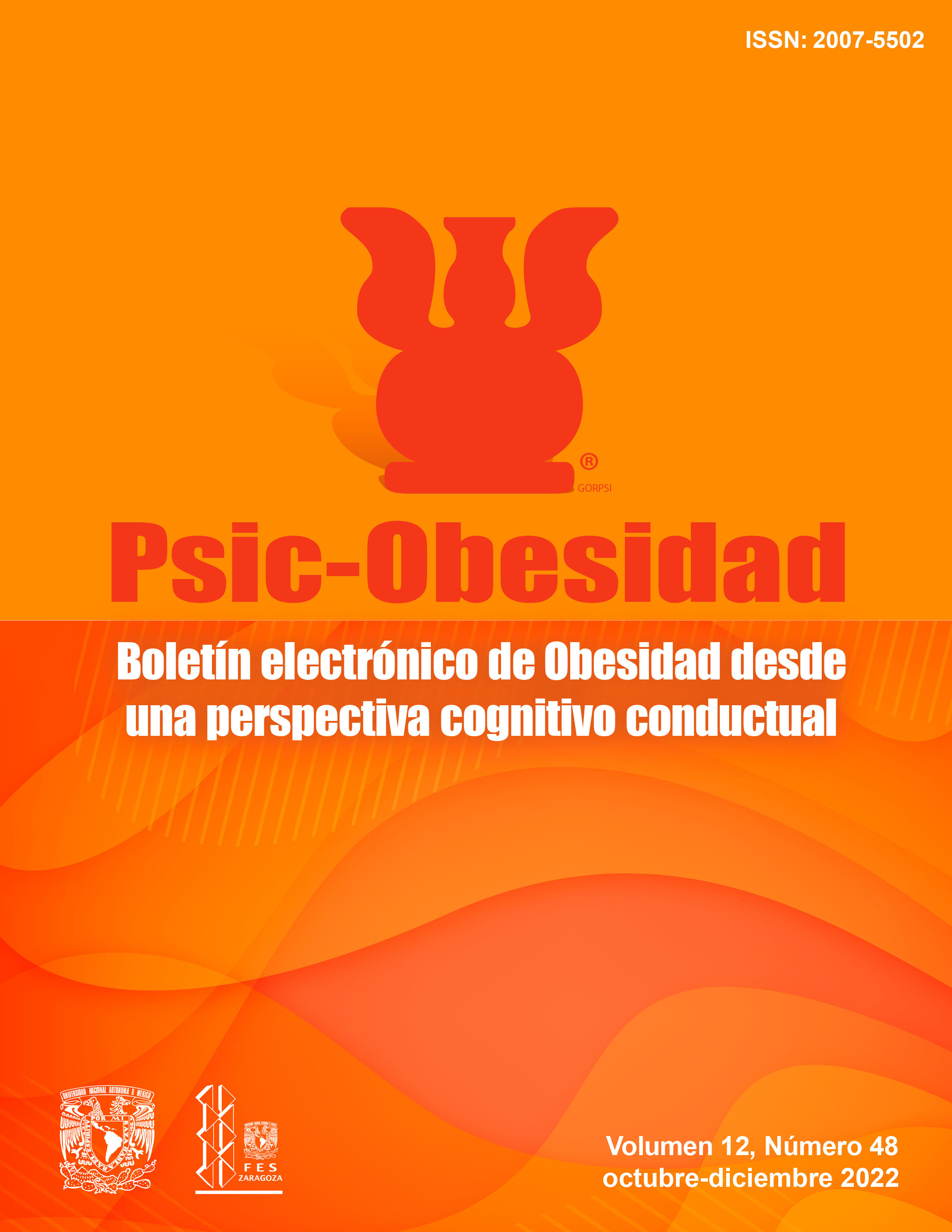Background of emotional factors associated with obesity
Main Article Content
Abstract
Emotions in the psychological area are widely studied phenomena, however, social emotions such as guilt and shame have been little taken into consideration, being delegated the importance they have in everyday life, it is a little developed territory in the psychological field. In Mexican society there are few studies that delve into the emotions of guilt and shame, giving them an almost null place in research as if they did not exist or were alien to the individual and society, but despite the little relevance placed on these emotions, feeling guilty or ashamed is clearly influenced by the unfounded moral conception in the family nucleus. It is necessary to extend and deepen the knowledge of these emotions in Mexican society to know if they experience the emotions of guilt and/or shame and to propose an intervention model with the purpose of providing the tools that may be necessary in the clinical and social areas.
Downloads
Article Details
References
Allport, G. W. (1966). La personalidad: su configuración y desarrollo. Herder.
Anderson, D. A. y Wadden, T. A. (1999). Treating the obese patient. Archives of
Barrett, L. F., Gross, J., Christensen, T. C., & Benvenuto, M. (2001). Knowing what you’re feeling and knowing what to do about it: Mapping the relation between emotion differentiation and emotion regulation. Cognition and Emotion, 15(6), 713–724. https://doi.org/10.1080/02699930143000239
Birren, J. E. (2000). I have to do it myself. En J.E. Birren, y J.F. Schroots, (Eds). A history of gerontopsychology in autobiography. American Psychological Ass.
Brownell, K. D. (1982). Obesity: Understanding and treating a serious, prevalent, and refractory disorder. Journal of Consulting and Clinical Psychology, 50(6), 820–840. https://doi.org/10.1037/0022-006X.50.6.820
Family Medicine, 8 (2), 156-167. https://doi.org/10.1001/archfami.8.2.156
Faubel, M. (1989). Body image and depression in women with early and late onset obesity. The Journal of psychology, 123(4), 385–395. https://doi.org/10.1080/00223980.1989.10542993
Flores-Ángeles, A. R. (1998). Autoconcepto. [Tesis de licenciatura]. Facultad de Psicología, UNAM.
Galimberti, U. (2009). Diccionario de psicología. Siglo XXI.
García, E., Vázquez, V., López, J. y Arcilla, D. (2003). Validez interna y utilidad diagnostica del eating disorder inventory en mujeres mexicanas. Salud pública de México, 45(3), 206-210. https://www.redalyc.org/pdf/106/10645312.pdf
Gardea, J. (2008). Moralidad y permisividad. [Tesis de maestría en filosofía]. Facultad de Filosofía y Letras, UNAM.
Garnica-Ojeda, E. R. (2006). Culpa y Vergüenza hacia la propia sexualidad: Un estudio comparativo homosexuales vs. Heterosexuales. [Tesis de licenciatura]. Facultad de Psicología UNAM. https://repositorio.unam.mx/contenidos/culpa-y-verguenza-hacia-la-propia-sexualidad-un-estudio-comparativo-homosexuales-vs-heterosexuales-441615?c=pngeL5&d=false&q=*:*&i=2&v=1&t=search_0&as=0
Gómez-Peresmitré, G. (1997). Alteraciones de la imagen corporal en una muestra de escolares mexicanos preadolescentes. Revista Mexicana de Psicología, 14, 31-40. https://www.researchgate.net/publication/339352501_REVISTA_MEXICANA_DE_PSICOLOGIA
Guillén Riebeling, R. del S. (2011). Trastorno de la personalidad por dependencia. Psic-Obesidad, 1(3), 6–9. https://www.zaragoza.unam.mx/wp-content/Portal2015/publicaciones/boletines/psicobesidad/boletin_psicobesidad_vol_1_no_3_julio_septiembre_2011.pdf
Palmero, F., Fernández, P., Martínez, F., y Chóliz, M (2002). Psicología de la Motivación y la Emoción. McGraw-Hill.
Reeve, J. (1994). Motivación y emoción. Mcgraw- Hill/Interamericana.
Rogers, C. (1961). El proceso de convertirse en persona. Paidos.
Stein R. F. (1987). Comparison of self-concept of nonobese and obese university junior female nursing students. Adolescence, 22(85), 77–90. https://pubmed.ncbi.nlm.nih.gov/3591506/
Vázquez, (2006). Obesidad con trastorno por atracon y sin trastorno: uso de eating disorder inventory (EDI- 2). [Tesis de licenciatura]. Facultad de Psicología, UNAM. https://repositorio.unam.mx/contenidos/obesidad-con-trastorno-por-atracon-y-sin-trastorno-uso-del-eating-disorder-inventory-edi-2-388117?c=1eRPpB&d=true&q=*:*&i=4&v=1&t=search_0&as=0
